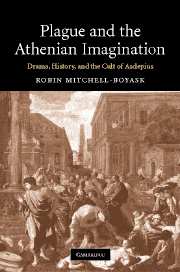Book contents
- Frontmatter
- Contents
- Preface
- Prologue
- Figure 1
- Chapter 1 Introduction
- Chapter 2 Death, myth and drama before the plague
- Chapter 3 Materials I: The language of disease in tragedy
- Chapter 4 Plague, cult and drama: Euripides' Hippolytus
- Chapter 5 Oedipus and the plague
- Chapter 6 The Trachiniae and the plague
- Chapter 7 Materials II: The cult of Asclepius and the Theater of Dionysus
- Chapter 8 Disease and stasis in Euripidean drama: Tragic pharmacology on the south slope of the Acropolis
- Chapter 9 The Athenian Asklepieion and the end of the Philoctetes
- Chapter 10 Conclusions and afterthoughts
- Works Cited
- Index
Chapter 9 - The Athenian Asklepieion and the end of the Philoctetes
Published online by Cambridge University Press: 22 September 2009
- Frontmatter
- Contents
- Preface
- Prologue
- Figure 1
- Chapter 1 Introduction
- Chapter 2 Death, myth and drama before the plague
- Chapter 3 Materials I: The language of disease in tragedy
- Chapter 4 Plague, cult and drama: Euripides' Hippolytus
- Chapter 5 Oedipus and the plague
- Chapter 6 The Trachiniae and the plague
- Chapter 7 Materials II: The cult of Asclepius and the Theater of Dionysus
- Chapter 8 Disease and stasis in Euripidean drama: Tragic pharmacology on the south slope of the Acropolis
- Chapter 9 The Athenian Asklepieion and the end of the Philoctetes
- Chapter 10 Conclusions and afterthoughts
- Works Cited
- Index
Summary
Fifteen to twenty years after the Trachiniae and roughly six after the Heracles of Euripides, Heracles returns to the Theater of Dionysus, though not as the lead role, in another tragic drama whose hero is a bearer of nosos and who stands in an ambivalent relationship with his community, and with no obvious connection to the city of Athens. However, one of the central paradoxes of Sophocles' Philoctetes, and of the efforts of modern interpreters to understand it, is the opposition between the drama's setting on the isolated, barren island of Lemnos, far from anything resembling a polis, and the pervasive consensus among a very diverse group of scholars that this work has something to do, however elusive it might ultimately be, with the nature of the Athenian polis at the end of the fifth century bce (Jameson 1956; Calder 1971; Segal 1981; Greengard 1987; Vickers 1987; Rose 1992). My contribution to clarifying this relationship will be to reexamine the text's discourse of healing and cure in the light of the associations among disease, social strife, the language of democracy, and the cult of Asclepius, the figure who, according to Heracles at the end of the drama, will finally cure Philoctetes.
- Type
- Chapter
- Information
- Plague and the Athenian ImaginationDrama, History, and the Cult of Asclepius, pp. 153 - 182Publisher: Cambridge University PressPrint publication year: 2007



